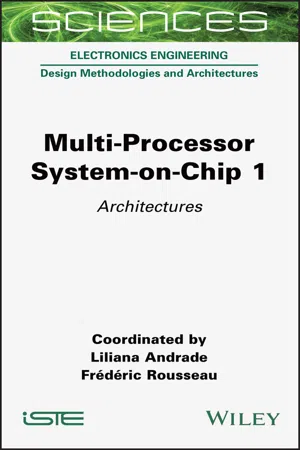
- English
- ePUB (mobile friendly)
- Available on iOS & Android
About this book
A Multi-Processor System-on-Chip (MPSoC) is the key component for complex applications. These applications put huge pressure on memory, communication devices and computing units. This book, presented in two volumes – Architectures and Applications – therefore celebrates the 20th anniversary of MPSoC, an interdisciplinary forum that focuses on multi-core and multi-processor hardware and software systems. It is this interdisciplinarity which has led to MPSoC bringing together experts in these fields from around the world, over the last two decades.
Multi-Processor System-on-Chip 1 covers the key components of MPSoC: processors, memory, interconnect and interfaces. It describes advance features of these components and technologies to build efficient MPSoC architectures. All the main components are detailed: use of memory and their technology, communication support and consistency, and specific processor architectures for general purposes or for dedicated applications.
Frequently asked questions
- Essential is ideal for learners and professionals who enjoy exploring a wide range of subjects. Access the Essential Library with 800,000+ trusted titles and best-sellers across business, personal growth, and the humanities. Includes unlimited reading time and Standard Read Aloud voice.
- Complete: Perfect for advanced learners and researchers needing full, unrestricted access. Unlock 1.4M+ books across hundreds of subjects, including academic and specialized titles. The Complete Plan also includes advanced features like Premium Read Aloud and Research Assistant.
Please note we cannot support devices running on iOS 13 and Android 7 or earlier. Learn more about using the app.
Information
PART 1
Processors
1
Processors for the Internet of Things
1.1. Introduction
- – smartphones and tablets;
- – smart doorbells with cameras, performing face detection for triggering an alert, accompanied by an image or video, on the owner’s smartphone;
- – smart speakers with voice control, employing local speech recognition for a limited vocabulary of voice commands while relaying other speech data into the cloud for more advanced analysis;
- – smart sensing devices used in agriculture to monitor and control, for example, soil quality, crop yield and livestock, while sporadically communicating data over cellular connections using, for example, NB-IoT protocols for low power consumption.
1.2. Versatile processors for low-power IoT edge devices
1.2.1. Control processing, DSP and machine learning
Table of contents
- Cover
- Table of Contents
- Title Page
- Copyright
- Foreword
- Acknowledgments
- PART 1: Processors
- PART 2: Memory
- PART 3: Interconnect and Interfaces
- List of Authors
- Author Biographies
- Index
- End User License Agreement